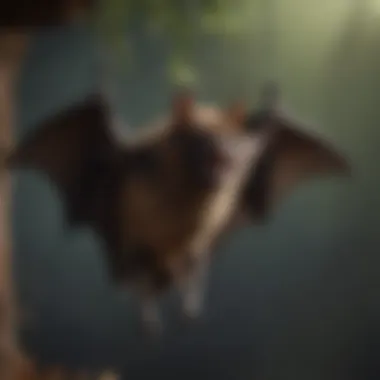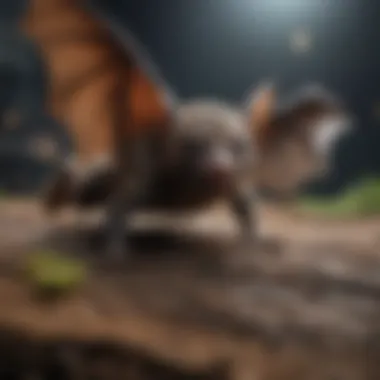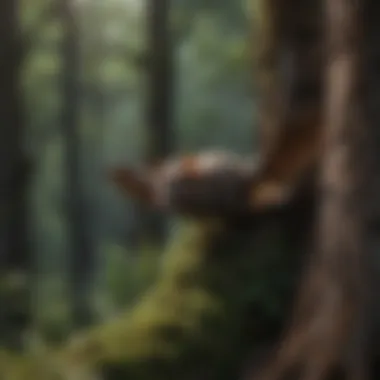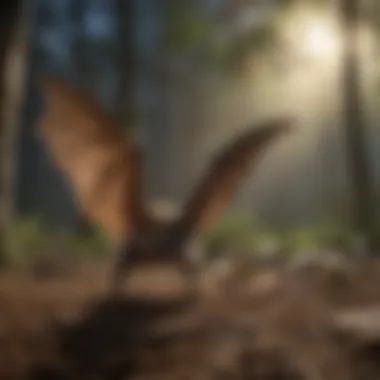Understanding Bat Lifespan: Influences and Implications


Intro
Bats are often misunderstood and sometimes unfairly stigmatized. These flying mammals play a crucial role in many ecosystems. Understanding bat lifespans is essential for grasping their ecological importance. This section provides an overview of bat characteristics, their environments, and broader context regarding their lifespan.
Animal Overview
Common Name and Scientific Classification
Bats belong to the order Chiroptera, which is derived from Greek, meaning 'hand-wing.' They are classified into two primary suborders: Microchiroptera and Megachiroptera. Microchiroptera consists of smaller bats, often insectivorous, while Megachiroptera includes larger fruit bats, like the flying fox. Some common species include the Little Brown Bat (Myotis lucifugus), and the Common Vampire Bat (Desmodus rotundus).
Physical Characteristics
Bats exhibit a variety of physical traits. Most have elongated fingers that support their wings, allowing for agile flight. Their sizes can vary significantly, from the tiny Bumblebee Bat (Craseonycteris thonglongyai), which weighs less than a penny, to the Giant Golden-Crowned Flying Fox (Acerodon jubatus), with a wingspan approaching six feet. Coloration also varies, generally manifesting in shades of brown, gray, or black.
Habitat and Distribution
Bats live in diverse habitats. They can be found in forests, deserts, wetlands, and urban areas across all continents except Antarctica. They often retain specific roosting spots such as caves, hollow trees, and buildings, which provide shelter and protection from predators. The Common Little Brown Bat ranges widely in North America, while the Flying Fox prefers tropical environments in Asia.
Behavior and Social Structure
Communication Methods
Bats communicate using a mix of vocalizations and echolocation. They produce various sounds, from high-frequency clicks to low-frequency calls, to convey warnings or locate prey. Echolocation allows them to navigate and hunt even in total darkness, illustrating their remarkable adaptations.
Social Hierarchies
Bats vary in social structure. Some species are solitary, while others form large colonies. Social interactions can include grooming and cuddling. This behavior supports social bonding and helps maintain colony cohesion.
Mating and Reproductive Behavior
Mating habits differ among bat species. Some employ seasonal breeding while others breed throughout the year. After mating, female bats typically exhibit delayed fertilization, where the sperm is stored until optimal conditions exist. Births often produce single live young, which develop rapidly to prepare them for life outside the roost.
Conservation Status
Current Population Trends
Many bat populations face significant decline due to factors like habitat loss and disease. The White-nose Syndrome, a fungal infection, has devastated several North American bat species, severely impacting their populations.
Threats and Challenges
Bats encounter numerous threats. Pesticide use diminishes insect prey. Urbanization alters their habitats. Climate change affects migration and breeding patterns, introducing uncertainties in their life expectancies.
Conservation Efforts and Success Stories
Conservation initiatives are underway globally. Organizations like Bat Conservation International work to protect bat habitats and promote awareness. Some species, like the California Myotis (Myotis californicus), have shown population recovery due to effective legislation and habitat preservation efforts.
Understanding bat longevity is crucial for biodiversity. It links to conservation efforts and helps maintain ecosystem health.
Preamble to Bat Lifespan
The subject of bat lifespan offers significant insights into the survival and sustainability of bat populations. Understanding how long bats live not only sheds light on their biology but also helps in assessing the health of ecosystems where they thrive. Bats play vital roles in several ecological processes, including pollination and pest control. Therefore, knowledge of their lifespan holds implications for biodiversity conservation efforts.
Definition of Lifespan in Bats
Lifespan in bats refers to the duration an individual bat lives, from birth to death. This measure can vary widely among different species, influenced by a consortium of factors. For example, while some small species may only live for a few years, larger bats can achieve life expectancies that extend beyond two decades. Thus, it's essential to recognize that lifespan is not uniform across the vast diversity that exists within the order Chiroptera.
Importance of Studying Bat Lifespan


Studying the lifespan of bats serves various important purposes. First, it helps wildlife biologists understand population dynamics. A species with a longer lifespan may have different reproductive strategies compared to shorter-lived species. This knowledge can inform conservation strategies as we seek to protect these animals.
Additionally, understanding bat longevity can elucidate responses to environmental changes. Environmental stressors such as habitat destruction, climate change, or disease can significantly affect the lifespans of bats. By monitoring these effects, researchers can gain insights into the broader impacts on ecosystems.
To summarize, the study of bat lifespan is not only a matter of curiosity but also a critical component in the conservation dialogue surrounding these often-overlooked mammals.
Overview of Bat Species
Understanding the diverse world of bats is essential when exploring their lifespan and longevity. Bat species exhibit a remarkable range of characteristics, behaviors, and ecological roles. This diversity directly impacts their life expectancies and makes it vital to assess different species in the context of their lifespan. Consumers of this knowledge include wildlife biologists, veterinarians, and conservationists who need to grasp the varied life experiences of these creatures.
Diversity Among Bat Species
Bats are one of the most diverse groups of mammals, with over 1,400 species identified globally. This diversity reflects a multitude of adaptations that help bats survive in different environments. For instance, fruit bats and insectivorous bats have vastly different diets, which influences their foraging behavior and reproduction.
Some notable examples of bat diversity include:
- Fruit bats (family Pteropodidae) are primarily frugivorous and are essential for pollination and seed dispersal.
- Vesper bats (family Vespertilionidae) are insect eaters and display various hunting techniques adapted to their habitats.
- Vampire bats (family Phyllostomidae) are unique for their blood-feeding behavior, which raises interesting questions about their longevity and health.
The significant variations in size, behavior, and habitat preferences highlight the need for specific research on each species' lifespans and ecological roles. The lifespan of bats can also vary greatly; some species live as little as three years, while others can thrive for over 30. This variation is essential to understand in the broader context of bat conservation and ecosystem health.
Global Distribution of Bats
Bats inhabit every continent except Antarctica, showcasing their adaptability to various climates and ecosystems. Their widespread distribution underscores their evolutionary success. Bats are found in forests, wetlands, deserts, and urban areas, demonstrating their ability to thrive in multiple settings.
Some critical points regarding the global distribution of bats:
- North America boasts a diverse range of species including the little brown bat and big brown bat.
- Asia is home to unique species such as the flying fox, which can have a wingspan of up to 1.5 meters.
- Australia has over 100 species of bats that play distinct roles in local ecosystems.
Understanding the distribution patterns of bats can offer essential insights into ecological networks. It provides clues about their life cycle, reproductive strategies, and ultimately their longevity. Additionally, global distribution studies are crucial for environmental assessments and informing conservation strategies aimed at protecting specific bat populations from the adverse effects of human activities.
Comparative Lifespan of Different Bat Species
Understanding the lifespan of various bat species is crucial for numerous reasons. Firstly, lifespans can provide insights into the evolutionary adaptations and survival strategies employed by different bats. Secondly, this knowledge aids scientists and conservationists in their efforts to protect these important animals. Bats face various threats, and understanding their lifespans can facilitate better management strategies.
Another vital aspect is related to biodiversity. Different lifespans among bat species mean varied roles in the ecosystem. For instance, knowing which species live longer or shorter can help in assessing their impact on food webs and nutrient cycling within different habitats.
Moreover, studying the longevity of bat species can reveal the health of ecosystems. Longer-lived species may indicate stable environments, while shorter lifespans can signal stressors affecting populations.
Short-Lived Bat Species
Short-lived bat species generally have life expectancies ranging between three to five years. These species often reproduce quickly and in higher numbers, compensating for their shorter lifespans. An excellent example is the Little Brown Bat (Myotis lucifugus), which has a brief life cycle. This species can produce multiple offspring each year, increasing the chances of population survival despite potential threats.
The shorter lifespan can influence their behavior and habitat usage. For instance, species that mature quickly often focus on establishing territory and securing food sources without the long-term investment seen in longer-lived bats. This rapid turnover means they are resilient to environmental changes. However, it also means they are vulnerable to sudden population declines.
Factors contributing to short lifespans can include predation, habitat destruction, and limited food availability. These stresses can culminate in a declining population, making it essential to monitor these species closely. Understanding their lifespans allows for better conservation prioritization.
Long-Lived Bat Species
In contrast, long-lived bat species can have life expectancies that extend well beyond 15 years, with some such as the Brandt’s Bat (Myotis brandti) reported to live up to 40 years in the wild. These species generally have slower reproductive rates, often producing only one pup per year. However, the investment in raising a single offspring may lead to greater survival rates for the young, which can benefit the species in the long term.
Longevity in bats can also relate to their metabolic rates and environmental adaptations. Long-lived species tend to inhabit stable environments where they face fewer risks from predators or habitat loss. They are often crucial in maintaining ecosystem balance due to their extended role as pollinators or pest controllers.
Ending
The comparative lifespan of bat species reveals significant differences driven by reproductive strategies and environmental factors. Knowing these differences enhances our understanding of bat biology and conservation needs. Effective conservation strategies must consider the diverse lifespans across bat species, ensuring both short-lived and long-lived bats thrive in their habitats.
Factors Influencing Bat Lifespan


Understanding the factors influencing bat lifespan provides critical insights into their biology and ecology. Different species exhibit varying lifespans, primarily due to genetic predispositions, environmental conditions, and dietary habits. These elements are key to unraveling how bats thrive in their specific environments and how their longevity affects ecological stability.
Genetic Factors
Genetic makeup is a significant determinant of lifespan in bats. Some species are genetically predisposed to longer lifespans, while others are not. For example, the Myotis brandtii, or Brandt's bat, can live for over 40 years, whereas others may have much shorter life expectancies.
Research indicates that large-bodied species tend to live longer than smaller ones. The genetic aspects influence resilience to diseases, reproductive rates, and overall health. Genes associated with longevity can provide insights into why certain species withstand environmental stresses better than others. Additionally, there are ongoing studies focusing on the genetics of aging in bats, which could unlock further understanding of their long lifespans.
Environmental Effects
The environment plays a crucial role in bat lifespan. Various factors, such as habitat availability, climate, and predation threats, interact with genetic predispositions. Bats living in rich, undisturbed habitats exhibit longer lifespans. When habitats are fragmentated or altereed due to human activities, the lifespan of bat populations decreases.
Diet and Foraging Behavior
Diet is another vital aspect influencing bat lifespan. Bats are diverse in their foraging strategies and dietary needs, which can impact their health and longevity. Species that consume a varied diet tend to have better overall health. For instance, fruit-eating bats contribute to ecosystem biodiversity through seed dispersal, which indirectly supports their lifespan.
Furthermore, the foraging behavior adopted by bats can lead to either longevity or vulnerability. Bats that forage in unstable environments may experience elevated stress levels that impact their health and survival rates. Adequate food helps maintain body condition, regulates reproductive health, and bolsters resistance to diseases. Bats that struggle to locate sufficient food sources are often at a higher risk of shortened lifespans.
In summary, the lifespan of bats is not predetermined solely by genetics but influenced by a wide spectrum of factors, including environmental conditions and dietary practices. Understanding these interactions is essential for effective conservation strategies.
Reproductive Strategies and Lifespan
Understanding the relationship between reproductive strategies and lifespan in bats is critical for comprehending their biology and conservation. This topic sheds light on how different reproductive behaviors can affect the longevity of bat species. Reproductive strategies encompass a range of traits, including mating rituals, gestation periods, and parental care. These strategies are not just about producing offspring; they also affect survival rates and population dynamics.
Reproductive Rate and Longevity
The reproductive rate of bats has significant implications for their lifespan. Species that reproduce more quickly or have multiple offspring often face higher mortality rates. This is primarily due to the increased energy demands associated with raising many young. Consequently, their longevity may be reduced when compared to species that invest heavily in fewer offspring but give them better chances of survival.
In general, bats exhibit a variety of reproductive rates. For instance, some species like the common pipistrelle may only have one pup per year, while others, such as the little brown bat, can have twins. The trade-off between quantity and quality of offspring is crucial in determining life expectancy. Additionally, bats that have longer gestation periods tend to have longer lifespans, as they invest more time in developing healthy offspring.
Role of Parental Care
Parental care is another important factor influencing bat lifespan. Some species demonstrate a high degree of care toward their young, which can enhance survival rates. For example, mother bats often nurse their pups for several weeks, allowing them to develop the strength and skills necessary to thrive independently. This maternal investment correlates with greater chances of reproductive success, thereby contributing to longer life spans within those species.
In contrast, bats that provide minimal parental care often see higher juvenile mortality rates. Without the protection and sustenance from parents, young bats may struggle to survive in their environments. This leads to decreased population stability and potentially lowers average lifespans across the species.
“The connection between reproductive strategies and longevity highlights the delicate balance of energy allocation in bats.”
In summary, reproductive strategies significantly affect bat lifespan. The balance between reproductive rate and parental investment plays a vital role in determining life expectancy. Understanding this dynamic is essential for developing effective conservation strategies aimed at protecting bat populations and their ecosystems.
Impact of Human Activities on Bat Lifespan
Human activities have a profound impact on the lifespans of bats, which are already vulnerable due to their unique biological and ecological traits. As these creatures navigate an ever-changing environment shaped by urban development, deforestation, and pollution, the effects on their longevity become more pronounced. Understanding how human actions affect bat lifespans is crucial to addressing the broader implications for biodiversity and ecosystem health. By exploring the specific elements of habitat destruction, climate change, and disease threats, we can better comprehend the urgency of conservation measures aimed at protecting these vital species.
Habitat Destruction
Habitat destruction is one of the primary threats that directly influence bat populations. Urbanization and agricultural expansion have led to the loss of natural habitats, critical for bats' survival. Forests, wetlands, and caves are often repurposed for human use, reducing the available space for bat roosting and foraging.
- Loss of Feeding Grounds: Bats rely on specific ecosystems to find food. When these areas are altered or destroyed, it can severely limit their access to insects and nectar.
- Disruption of Roosting Sites: Many bats require specific types of roosting sites, such as tree hollows or cave systems. Habitat loss often displaces them from these critical locations.
The stress of adapting to new environments can lead to shorter life spans as bats struggle to find food and shelter. In addition, fragmentation of habitats can isolate bat populations, reducing genetic diversity and resiliency.
Climate Change Effects
Climate change presents an escalating threat to bat lifespans as it alters the environmental conditions essential for their survival. Changes in temperature, precipitation patterns, and seasonal cycles can disrupt the delicate balance within their ecosystems. This can have several negative consequences:
- Food Availability: Shifts in insect populations, which many bats depend on, can occur due to quickly changing climates. If insects' life cycles do not align with the bats’ breeding and feeding periods, it could lead to food shortages.
- Extreme Weather Events: Increased frequency of storms and heatwaves can directly affect bat health and survival rates. Young bats are particularly vulnerable to these changes.
- Habitat Alterations: As ecosystems change, the areas where bats find suitable roosts and forage may also shift, leading to displacement and increased competition for resources.


Overall, the impact of climate change extends the challenges that bats already face, leading to shorter lifespans and population declines.
Threats from Disease
Bats are also susceptible to various diseases, many of which are exacerbated by human activity. The introduction of pathogens, often associated with habitat destruction and stress from environmental changes, poses a significant threat. Notable diseases affecting bats include white-nose syndrome and rabies. The implications are concerning:
- Direct Mortality: Diseases can result in significant mortality rates in local populations, drastically reducing their numbers and impacting their longevity.
- Immune System Deterioration: Stress from habitat loss and climate change can weaken bats' immune systems, making them more vulnerable to infections.
- Transmission Risks: As habitats become more fragmented, the risk of zoonotic diseases spreading increases, further threatening bat populations and, potentially, other wildlife and human communities.
Significance of Bats in Ecosystems
Bats play a critical role in maintaining healthy ecosystems. Their influence spans various aspects of ecological balance, making their conservation essential. Understanding the significance of bats helps clarify why studying their lifespan and sustainability matters. As natural pollinators and pest controllers, bats contribute significantly to agriculture and biodiversity.
Bats as Pollinators
Bats are essential pollinators for many plants. The species that primarily engage in this behavior tend to be fruit bats or megabats. They visit numerous flowers in search of nectar. During these visits, pollen sticks to their fur and is transferred between flowers. This activity aids in reproduction of various plants, which is crucial for maintaining plant diversity and growth. For instance, bats are necessary for many fruit trees, including the agave plant, which is vital for tequila production.
Key points about bats as pollinators include:
- Diverse Flower Interaction: Bats typically visit flowers that bloom at night. This makes them unique among pollinators, as they facilitate a different range of flora.
- Economic Benefits: The pollination by bats directly contributes to crops such as bananas, mangoes, and avocados. A decline in bat populations can lead to reduced agricultural yields.
- Ecosystem Health: Pollination by bats supports various species of plants, aiding in habitat stability and biodiversity.
Conservation of Bats and Their Lifespan
Conservation of bats is crucial for maintaining their populations, which have significant roles in ecosystems. Bats contribute to pollination and pest control, promoting biodiversity. Their lifespan is affected by various environmental factors, meaning that conservation efforts can directly impact their longevity. By preserving habitats and creating sustainable environments, we ensure that bat species can thrive, which in turn supports broader ecological health.
Current Conservation Efforts
Many organizations are actively engaged in conservation efforts aimed at protecting bat species and their habitats. Some key initiatives include:
- Habitat Restoration: This involves reclaiming areas damaged by human activity to restore natural ecosystems where bats can thrive.
- Research Programs: Studies are conducted to understand bat behavior, migration patterns, and health. This information guides effective conservation strategies.
- Legislation: Protections for bats have been enacted in various regions. Laws help limit habitat destruction and protect critical breeding grounds.
- Public Awareness Campaigns: Educational programs inform the public about the importance of bats and how to assist in their conservation.
These efforts help rebuild bat populations, contributing to healthier ecosystems.
Future Challenges and Strategies
Despite ongoing conservation efforts, significant challenges remain that threaten bat lifespans. These challenges include:
- Climate Change: Fluctuating temperatures and changing habitats can disrupt feeding and breeding cycles of bats.
- Human Encroachment: Urbanization continues to intrude into natural habitats, leading to habitat loss.
- Diseases: Emerging diseases, such as White-nose Syndrome, have devastating effects on bat populations.
To address these challenges, the following strategies are essential:
- Enhanced Research: Continuous monitoring of bat populations and health can aid in early detection of diseases and environmental changes.
- Community Engagement: Engaging local communities in conservation efforts ensures local support and promotes sustainable practices.
- Policy Improvement: Laws must adapt to new scientific findings to enhance protections for bats effectively.
Ending
The conclusion of this article encapsulates the essential insights into bat lifespan and its broader implications. It is vital to understand that bat longevity is not just a biological curiosity; it has real-world impacts on ecosystems and biodiversity. Consider that bats play an integral role in pest control and pollination. Their lifespans can directly affect these crucial functions.
Several factors contribute to the lifespan of these mammals. Genetic predispositions, environmental conditions, dietary habits, and the threats posed by human activities like habitat destruction and climate change all interplay in complex ways to determine how long bats live. Understanding these variables enables better conservation strategies, fostering healthier bat populations.
Moreover, by knowing the typical lifespans of different bat species, we can tailor conservation efforts more effectively. For instance, species with shorter lifespans may need more immediate protections compared to long-lived species. This understanding can lead to a more nuanced approach to bat conservation, focusing on specific needs and vulnerabilities.
"The survival of bats is not merely a matter of their existence, but of maintaining the intricate balance within our ecosystems."
As we sum up the findings, it's clear that the implications of bat lifespan ripple through the fabric of nature, impacting both human activity and ecological health. Consideration of bat lifespan should prompt collective action among stakeholders, from policymakers to local communities.
Summary of Key Points
- Bat lifespan varies significantly among species, with some living only a few years and others thriving for several decades.
- Factors like genetics, environment, diet, and human impact play a critical role in determining lifespan.
- Bats contribute significantly to ecosystems, serving as pest controllers and pollinators.
- Conservation efforts must adapt to the specific needs dictated by the lifespans of different bat species.
Call to Action for Bat Conservation
The necessity of bat conservation cannot be overstated. Given their roles in ecosystem health, it becomes imperative that we act now.
- Raise Awareness: Educate communities about the importance of bats and the dangers they face. This can help foster a culture of respect and protection towards these animals.
- Support Conservation Efforts: Participating in or donating to organizations dedicated to bat protection can help alleviate some of the threats. Groups like the Bat Conservation International focus on research and advocacy efforts.
- Advocate for Policy Changes: Work with local governments and conservation bodies to implement laws that protect bat habitats and monitor populations.
- Encourage Research: Support studies related to bat biology, ecology, and conservation. Such findings guide effective strategies and policies.
As the balance within our ecosystems hangs in the balance, safeguarding bat populations is not just an environmental concern—it is a responsibility we all share. Individual and collective actions today can ensure a future where these remarkable creatures continue to thrive alongside us.







